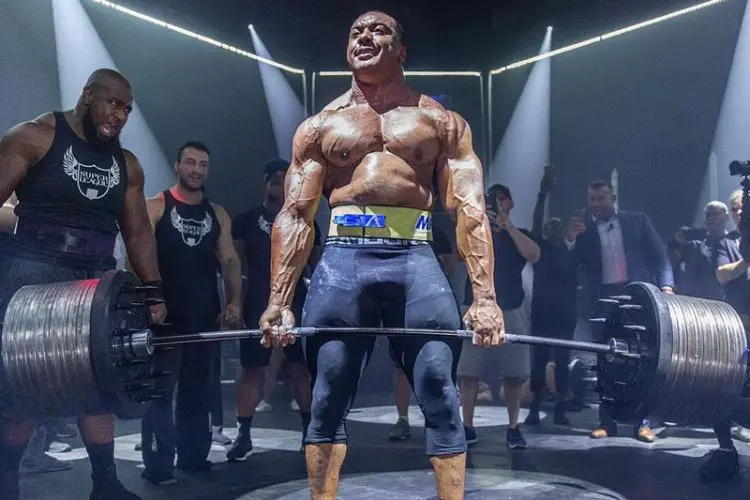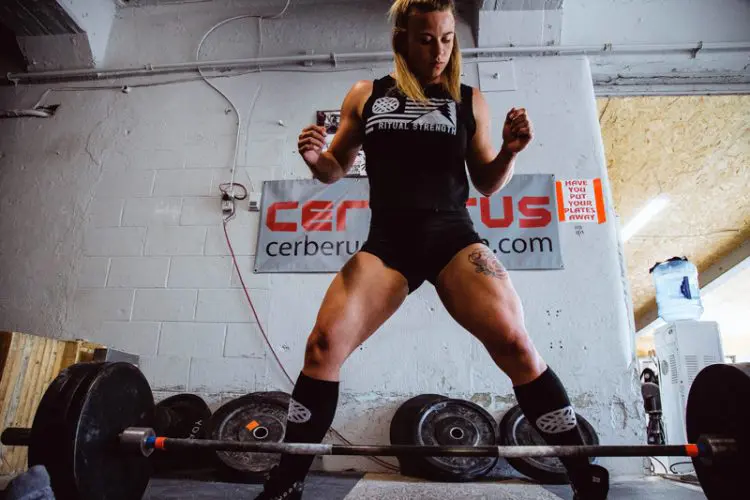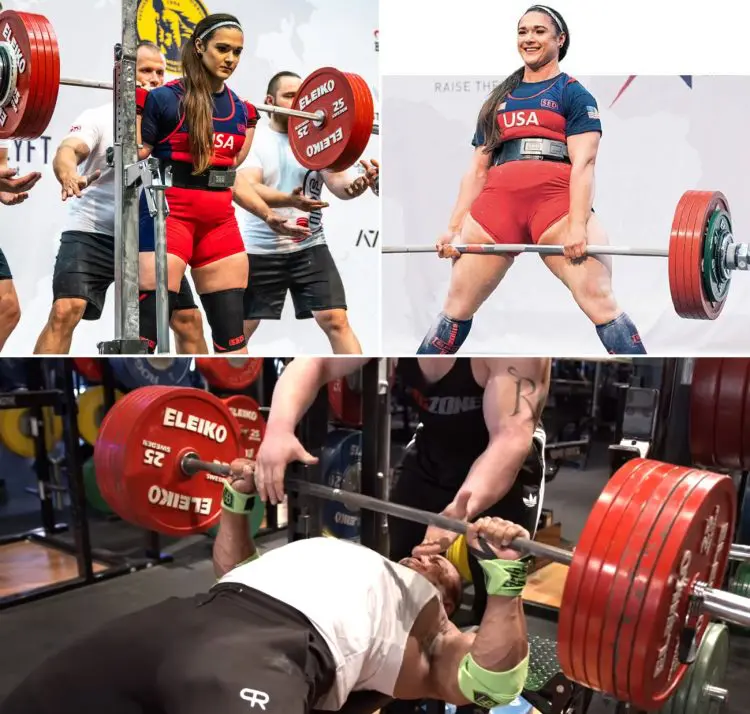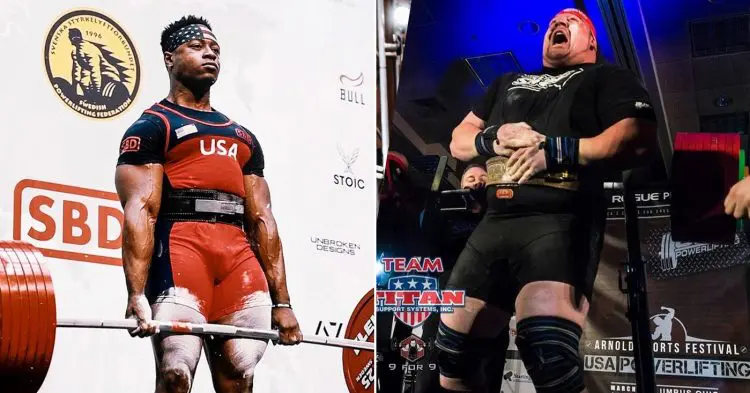Dive into our comprehensive powerlifting guide to master techniques, training schedules, and essential tips for beginners and seasoned athletes alike.
As a veteran powerlifting coach, I’ve helped hundreds of beginners start their powerlifting journey. On the other hand, I’ve helped countless advanced lifters crush their personal bests.
If you’ve been thinking about getting into powerlifting, you’ve come to the right place.
A systematic review published in the Journal of Strength and Conditioning Research found that daily 1-repetition maximum training can help enhance overall strength and performance. (1)
Before starting, it is imperative that you have an understanding of the sport of powerlifting.
Therefore, this article will provide you with all of the information that will help you understand the demands of the sport and allow you to make the best start possible.
Level Up Your Fitness: Join our 💪 strong community in Fitness Volt Newsletter. Get daily inspiration, expert-backed workouts, nutrition tips, the latest in strength sports, and the support you need to reach your goals. Subscribe for free!
What is Powerlifting?
Powerlifting is a strength sport that tests your maximal strength capacity. It does this by assessing your performance on three lifts — squat, bench press, and deadlift.
In this in-depth powerlifting guide, we will delve into everything you need to know about the sport.
In a powerlifting meet, you are granted three attempts to lift as much weight as you possibly can.
All of your lifts are recorded. Once you have performed all three lifts, the maximum amount of weight you lifted will be tallied to give your final maximum total and placing.
For example, if a lifter’s best lifts include a 300-pound squat, 200-pound bench press, and 350-pound deadlift, their accumulative total will be 850 pounds.
The individual who sets the biggest total will win their respective weight class.
History of Powerlifting
No powerlifting guide can be deemed complete without discussing the sport’s history.
Knowing the history of powerlifting and the story of how it all began can help you better connect with the sport.
Strongman Competitions (Ancient Beginnings To 19th Century)
It would be safe to say that strongman training is the OG strength sport. Much before the front-double bicep pose was introduced or the barbell was invented, folks around the world were lifting heavy stones and pulling chariots to prove they were the strongest.
In the 19th century, strength exhibitions became popular entertainment. Strongmen (and women) toured with circuses and vaudeville shows, performing acts of strength that captivated audiences. This played a huge role in bringing strength sports into the mainstream.
Around the same time, Eugen Sandow, “The Father of Modern Bodybuilding,” popularized barbell training. People slowly started adding barbell exercises into their fitness regimens.
Olympic weightlifting (snatch and clean & jerk) started gaining popularity in the 19th century. It was among the few sports featured at the first modern Olympic Games in Athens in 1896.
Mid-20th Century (The Birth of Powerlifting)
The 1950s marked a pivotal moment for strength sports. Dissatisfied with the limitations of Olympic weightlifting, which focused on two lifts, a group of passionate lifters in England and the United States decided to start competitive powerlifting, which included three lifts — squat, bench press, and deadlift.
In 1964, the International Powerlifting Federation (IPF) was established. The National Powerlifting Championships in 1964 was a turning point, bringing athletes together under a unified set of guidelines. New weight classes, equipment standards, and drug testing were also introduced, laying the foundation for the sport’s future.
What are The Benefits of Powerlifting?
Powerlifting’s primary objective is to help you build total body strength.
All powerlifting training programs revolve around the three big lifts — deadlift, bench press, and squat. Most have accessory lifts to strengthen the primary and secondary muscles with other compound and isolation lifts.
Each of the three powerlifting exercises works several muscles throughout the body, and therefore, regularly performing them will improve full-body strength.

Additionally, when considering strength training, research shows that heavy-weight training has the most substantial impact on strength development (2).
Engaging in strength training has been associated with a number of health and fitness benefits, including:
- Better Movement
- Enhanced Mood
- Improved Balance, Coordination, and Stability
- Reduced Injury Risk
- Reduced Risk of Chronic Disease
- Stronger Bones and Soft Tissues (3)
What Are The Limitations of Powerlifting?
Training-related injuries pose the biggest risk in powerlifting. This stems from regularly lifting weights at or near one’s maximum capacity.
When the weight is light, it is much easier to maintain good exercise form. However, when the load increases, your technique can begin to break down.
Combining poor technique with lifting heavy weights significantly increases injury risk.
I can’t overemphasize this in this powerlifting guide; as a beginner, you must ensure that you spend plenty of time perfecting your technique. Doing so will significantly reduce the risk of technique-related injuries when lifting heavy.
Powerlifting has also been criticized for its one-dimensional approach. Because all of the focus is on strength development, it can be easy to neglect other important fitness components, such as mobility and conditioning.
Getting Started with Powerlifting
Using the right equipment can make all the difference in your lifting performance. In this powerlifting guide, we discuss the best training equipment to supercharge your workouts:
Powerlifting Equipment Essentials
Footwear
The right footwear can make a significant impact on your lifting performance. The right pick of powerlifting shoes will depend on your body mechanics.
For example, some people find weightlifting shoes (raised heels) more optimal for squatting. On the flip side, others are more comfortable squatting in barefoot shoes.
Irrespective of your body mechanics, you should be deadlifting in flats (or barefoot shoes), as it ensures the barbell has to travel the smallest path.
Similarly, most people prefer wearing flats while bench pressing. It helps them establish a better ground contact.
Supportive Belt
A robust lifting belt is crucial for supporting your lower back during heavy lifts, especially squats and deadlifts.
It helps increase intra-abdominal pressure, safeguarding your core and enabling you to lift heavier weights safely.
There are different types of weightlifting belts that you can get. We have covered the 12 best powerlifting belts that money can buy. Check them out here.
Wrist Wraps
These provide additional wrist support, particularly beneficial during the bench press and squats. Stabilizing your wrists prevents strain and enhances your ability to handle heavy weights.
I recommend getting wrist wraps with thumb loops, as they make it easier to put them on and get them off. Check out the best lifting wraps in this article.
Knee Sleeves
While not mandatory, knee sleeves offer your knee joints warmth, compression, and support. They can help improve performance and protect against injuries, especially during squats.
Knee sleeves brace your joints during eccentrics, which can help build a spring-like effect at the bottom of the range of motion. Ensure that you check your powerlifting federation rules before picking any training equipment.
Chalk
Don’t underestimate the power of chalk in powerlifting. I have no shame in admitting that some of my best deadlift performances have been powered by magnesium carbonate — gym chalk.
I highly recommend people with a weak grip chalk up and watch their bar rocket off the floor. Plus, applying chalk on your shins and thighs can make the bar roll up to the lock-out position more effortlessly.
Applying chalk on your upper back can also help keep the barbell in place during squats.
That said, make sure you’re not creating a mess in the gym while using chalk. Be mindful, and the gym owner will love you for it.
Gym Selection Tips
Where you train can make a big impact on your training performance and progress. Here are the most important things to consider while choosing a powerlifting gym:
Equipment Quality
Seek a gym with a reputation for maintaining high-quality, robust equipment. Essential gear includes power racks, bench press stations, barbells, and a variety of weight plates.
Most serious powerlifting gyms use calibrated weight plates, which gives you the closest comp experience.
Community and Culture
A gym with a supportive community and a culture that celebrates strength training can be incredibly motivating. Look for places where fellow lifters share your passion for powerlifting, offering both inspiration and practical advice.
Coaching Availability
Especially for beginners, access to experienced coaches or personal trainers familiar with powerlifting can accelerate their progress.
Experienced coaches can provide personalized feedback, technique refinement, and program adjustments.
Space and Availability
A crowded gym can hinder your training schedule. Opt for a gym that offers ample space and equipment availability, reducing wait times and allowing for a more efficient workout.
Powerlifting Considerations
Before diving into powerlifting or signing up for your first-ever competition, there are a number of considerations that you must make.
The Three Powerlifts
Powerlifting revolves around three core lifts: the squat, deadlift, and bench press. Competitors aim to lift the maximum weight possible in these exercises during competitions.
Different powerlifting federations allow various lifting forms and setups.
Deadlift
With the deadlift, you can either use the conventional deadlift stance or the sumo (wide) stance.
Ultimately, you should use the deadlift variation that allows you to lift the heaviest.
For most people, this will be the sumo deadlift, as the wide stance shortens the range of motion and typically allows for more weight to be lifted.
Squat
You can choose between the high or low bar squat setups. These variations refer to the position of the bar on the back.
With the high bar squat, the bar sits just above the shoulder blades, whereas with the low bar, the bar sits directly on top of the shoulder blades.
While this may seem like an insignificant difference, the bar position will influence your trunk position as you squat.
The high bar squat will keep the trunk more upright, while the low bar squat will cause the trunk to tip forward to a greater degree.
As your powerlifting guide, let me tell you this: not only does the high bar position give you a mechanical advantage, but it also activates powerful posterior muscles, such as the glutes and hamstrings, to a greater degree, allowing you to generate more force.
Level Up Your Fitness: Join our 💪 strong community in Fitness Volt Newsletter. Get daily inspiration, expert-backed workouts, nutrition tips, the latest in strength sports, and the support you need to reach your goals. Subscribe for free!
Bench Press
You could pick between a shoulder-width or wider grip on the bench press.
Just like with the squat, a wider stance limits the range of motion, which can allow you to lift heavier.
According to a systematic review, low-bar squats and wide-grip bench presses are advantageous for moving greater loads. (1)
Powerlifting Federation
While the most popular powerlifting federation is the International Powerlifting Federation (IPF), several other federations exist.
The majority of these federations have come about due to differences regarding drug use and testing.
Notably, there isn’t a universal set of rules for powerlifting comps. Although there are some commonalities, the specific rules and regulations can differ significantly from one federation to another.
For example, some federations have a very strict drug-use policy, while others permit the use of performance-enhancing drugs.
There is also variance between federations in regard to competitions, weigh-in protocols, and weight classes.
Therefore, it’s crucial that you familiarize yourself with the rules and regulations of different powerlifting federations to help you choose the organization that best suits your preferences.
Raw or Equipped?
Once you have selected the federation that suits your preferences, you must then choose between raw or equipped competitions.
As the names suggest, you are not allowed to use any training aids in raw competitions (with the exception of a lifting belt, knee sleeves, and wrist wraps).
However, in equipped competitions, you are permitted to use additional equipment such as squat suits and bench shirts, knee wraps, and lifting straps.
This equipment allows the athletes to lift heavier and set bigger totals. (4)
Ultimately, neither category is superior to the other. Whether you lift raw or equipped is up to you. That said, if your main goal is to lift as much weight as humanly possible, you should consider equipped lifting.
Selecting A Weight Class
In case you didn’t know, powerlifting competitors are categorized by weight classes. This ensures a leveled playing field.
If it weren’t for weight classes, lighter athletes would be at a significant disadvantage. (5)
Before a competition, athletes are required to undergo a weigh-in to qualify for their weight category.
You can find the different weight classes in the table below. As you will see, the IPF uses a weight class system that differs from the majority of other powerlifting federations.
| International Powerlifting Federation | Other Federations | ||
| Male | Female | Male | Female |
| 59 kg / 130 lbs | 47 kg / 104 lbs | 56 kg / 123 lbs | 44 kg / 97 lbs |
| 66 kg / 145 lbs | 52 kg / 115 lbs | 60 kg / 132 lbs | 48 kg / 106 lbs |
| 74 kg / 163 lbs | 57 kg / 127 lbs | 67.5 kg / 148 lbs | 52 kg / 115 lbs |
| 83 kg / 183 lbs | 63 kg / 139 lbs | 75 kg / 165 lbs | 56 kg / 123 lbs |
| 93 kg / 205 lbs | 72 kg / 159 lbs | 82.5 kg / 181 lbs | 60 kg / 132 lbs |
| 105 kg / 231 lbs | 84 kg / 185 lbs | 90 kg / 198 lbs | 67.5 kg / 148 lbs |
| 120 kg / 265 lbs | > 84 kg / > 185 lbs | 100kg / 220 lbs | 75 kg / 165 lbs |
| > 120 kg / > 265 lbs | – | 110 kg / 242 lbs | 82.5 kg / 181 lbs |
| – | – | 125 kg / 275 lbs | 90 kg / 198 lbs |
| – | – | 140 kg / 308 lbs | > 90 kg / > 198 lbs |
| – | – | > 140 kg / > 308 lbs | – |
(This comprehensive table is one of the reasons this article is the best powerlifting guide on the internet.)
Powerlifting Meets
Before you enter a competition, it’s crucial to familiarize yourself with its rules to streamline your prep.
By now, you probably know that powerlifting competitions assess the squat, bench press, and deadlift performance.
For each exercise, an athlete is allotted three attempts to lift the maximum weight possible.
The order of most powerlifting meets is usually squat, then bench press, and finally deadlift.
Before taking the field, you should already have an idea of your goal weight for each lift. This will be based on your performance in the gym in the lead-up to the event.
Most athletes open with a weight that they know they can lift relatively comfortably. They will then use the following two attempts to hit their goal weight or more.
Notably, your lifts must conform to the federation’s criteria, or they won’t be registered.
Squat
In the squat, after unracking the bar, you must wait for the ‘squat’ command before starting the eccentric phase. This command is only given once you’re in a stable stance with your knees locked.
Having completed the squat, you must wait for a ‘rack’ command before reracking the bar.
Bench Press
With the bench press, once the bar has been unracked with the elbows locked, you will get a ‘start’ command to lower the bar to the chest.
You must hold the bar in contact with the chest until you get a ‘press’ command to press the bar up. Once again, you must wait for a ‘rack’ command before reracking the bar.
Deadlift
Similarly, for the deadlift, once you have pulled the bar to the hips and locked the hips and knees, you will be given a ‘down’ command to lower the bar back to the floor.
If you fail to follow commands or do not lift in accordance with the lifting criteria, you will get a red light, and the lift will not count towards your total.
If you’ve never been to a powerlifting competition, it’s strongly advised to attend one before entering your first contest.
Attending an event will familiarize you with the procedures of a powerlifting competition. This will help you feel much more confident and less anxious when it finally comes to competing.
Training For Powerlifting
Evidently, the most important aspect of preparing for a competition is your training. If your training is not well thought through or consistent enough, your performance will suffer.
I highly recommend beginners hire a powerlifting coach with a proven track record. Coaches can also help support your prep for a competition.
Furthermore, there are several top-notch powerlifting programs that can help you prepare for your first-ever competition.
Powerlifting Programs
Probably the most popular powerlifting beginner plan of all is the 5/3/1 program created by ex-powerlifter and coach Jim Wendler.
As the name may suggest, this program focuses on performing sets of five reps, three reps, and one rep for all “big” lifts, including the deadlift, squat, and bench press.
This program is brilliant for aspiring powerlifters as it allows you to make rapid progressions with your strength, as well as help you become accustomed to lifting heavy weights.
There are many other excellent beginner strength training programs that beginner powerlifters can benefit greatly from. These include:
- The Cube Method
- Candito LP
- Greyskull LP
- GZCLP
- Madcow 5×5
- nSuns LP
As you gain experience, you may notice that a particular lift requires more attention than the others.
In this instance, you should consider switching to a more advanced training program to enhance your performance in the deadlift, squat, or bench press.
Some examples of intermediate/advanced powerlifting programs include:
- The Bulgarian Squat Method
- Candito Advanced Bench Press Program
- Coan & Phillipi Deadlift Program
- Greg Nuckols 28 Programs
- The Smolov Method
Sample Powerlifting Workouts
This powerlifting guide includes three sample powerlifting workouts. Each session focuses on developing one of the three power lifts.
Workout 1: Squat (Powerlifting guide)
| Exercise | Training Volume (Sets x Reps) |
| A) Warm-Up:
– Standing Quad Stretch – Box Stretch – Air Squats |
2 x 20s 2 x 20s 2 x 10 |
| B) Barbell Back Squat | 4 x 8 (50 – 70% of 1RM)
5 x 5 (70%) |
| C) Barbell Pause Squat | 3 x 5 (50%) |
| D) Lat Pulldown | 3 x 10 |
| E) Dumbbell Side Bends | 3 x 12 |
Workout 2: Deadlift
| Exercise | Training Volume (Sets x Reps) |
| A) Warm-Up:
– Downward-Facing Dog – Single-Leg Deadlift – Kettlebell Jefferson Curl |
2 x 20s 2 x 20s 2 x 10 |
| B) Barbell Deadlift | 4 x 8 (50 – 70% of 1RM)
5 x 5 (70%) |
| C) Banded Barbell Deadlift | 3 x 5 (70%) |
| D) Barbell Bent Row | 3 x 10 |
| E) Weighted Sit-Ups | 3 x 12 |
Workout 3: Bench Press
| Exercise | Training Volume (Sets x Reps) |
| A) Warm-Up:
– Wall Stretch – Banded Tricep Extensions – Dumbbell Fly |
2 x 20s 2 x 10 2 x 10 |
| B) Barbell Bench Press | 4 x 8 (50 – 70% of 1RM)
5 x 5 (70%) |
| C) Close-Grip Barbell Bench Press | 3 x 5 (70%) |
| D) Incline Dumbbell Bench Press | 3 x 10 |
| E) Tricep Pulldown | 3 x 10 |
Nutrition for Powerlifters
Many aspiring powerlifters never see any progress, not because their training program is ineffective but because their nutrition and recovery are not on point.
Here are the best nutritional strategies to support strength gains and recovery:
- Protein: Aim for 1.5 to 2 grams of protein per kilogram of body weight daily. Protein is the building block of muscle and is essential for repair and growth. Opt for high-quality sources like lean meats, fish, dairy, and legumes.
- Carbs: Prioritize complex carbohydrates such as whole grains, vegetables, and fruits. They ensure a steady energy supply for grueling workouts and aid in recovery.
- Fats: Don’t shy away from healthy fats. Avocados, nuts, seeds, and olive oil can help with hormone production, including those vital for muscle growth.
- Hydration: Water supports metabolic processes and nutrient transport. Aim for at least 3 liters daily, more if you are a heavy sweater.
Recovery Techniques for Powerlifters
Here is a low-down on how to streamline your recovery as a powerlifter:
- Sleep: Aim for 7-8 hours of sleep each night. Sleep is when your body recovers and builds muscle.
- Mobility: Incorporate mobility work and stretching into your routine to improve flexibility, reduce injury risk, and aid muscle recovery.
- Active Recovery: Light activities on rest days, like walking or swimming, can boost blood circulation, helping shuttle nutrients to sore muscles and speed up recovery.
Conclusion
Powerlifting is one of the most popular strength sports. There are several factors that you must consider before starting your powerlifting journey, including the federation, raw or equipped, and weight class.
If you have any questions about this powerlifting guide or any other aspect of powerlifting, let us know in the comments below, and I’ll be happy to help!
References:
- Ferland, P. M., & Comtois, A. S. (2019). Classic Powerlifting Performance: A Systematic Review. Journal of strength and conditioning research, 33 Suppl 1, S194–S201. https://doi.org/10.1519/JSC.0000000000003099
- Schoenfeld, Brad J.; Contreras, Bret; Vigotsky, Andrew D.; Peterson, Mark (2016-12-01). “Differential Effects of Heavy Versus Moderate Loads on Measures of Strength and Hypertrophy in Resistance-Trained Men”. Journal of Sports Science & Medicine. 15 (4): 715–722. ISSN 1303-2968. PMC 5131226. PMID 27928218.
- Westcott, Wayne L. (2012-07). “Resistance training is medicine: effects of strength training on health”. Current Sports Medicine Reports. 11 (4): 209–216. doi:10.1249/JSR.0b013e31825dabb8. ISSN 1537-8918. PMID 22777332.
- Blatnik, Justin A.; Skinner, Jared W.; McBride, Jeffrey M. (2012-12). “Effect of supportive equipment on force, velocity, and power in the squat”. Journal of Strength and Conditioning Research. 26 (12): 3204–3208. doi:10.1519/JSC.0b013e3182736641. ISSN 1533-4287. PMID 22996018.
- Ten Hoor, Gill A.; Plasqui, Guy; Schols, Annemie M. W. J.; Kok, Gerjo (2018-03-01). “A Benefit of Being Heavier Is Being Strong: a Cross-Sectional Study in Young Adults”. Sports Medicine – Open. 4. doi:10.1186/s40798-018-0125-4. ISSN 2199-1170. PMC 5833324. PMID 29492711.












Thank you for having the time and effort on sharing this amazing blog with us! I’ll probably read more of your articles.